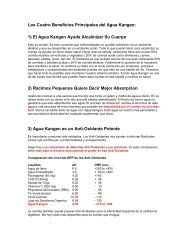ACID-ALKALINE BALANCE: ROLE IN CHRONIC ... - My Kangen Tools
ACID-ALKALINE BALANCE: ROLE IN CHRONIC ... - My Kangen Tools
ACID-ALKALINE BALANCE: ROLE IN CHRONIC ... - My Kangen Tools
You also want an ePaper? Increase the reach of your titles
YUMPU automatically turns print PDFs into web optimized ePapers that Google loves.
Vol. 234, No. 1, 1997<br />
BIOCHEMICAL AND BIOPHYSICAL RESEARCH COMMUNICATIONS<br />
catechin and tannic acid, as well as SOD, did not show<br />
suchastronginitial transientemission ofCL (datanot<br />
shown).Injectionofthesolventwithoutenzymedidnot<br />
resultinanemissionofCL.Moredetailedexperiments<br />
willbeneededtoclarifythemechanismofthisphenomenon.<br />
The inhibitory effect of reduced water on the accumulation<br />
of O •0<br />
2 was increased in a dose-dependent<br />
manner as shown in FIG. 2D, suggesting the stoichiometric<br />
action of active substance in reduced water.<br />
Definition of the SOD-like activity of reduced water.<br />
Since this paper first reports the O •0<br />
2 scavenging activity<br />
of electrolyzed-reduced water, the standardization<br />
of this activity is needed to compare the reducing potencyofthereducedwaterpreparedeachtime.Inorder<br />
to standardize the reducing potency of the reduced water,<br />
we defined a IC50SO unit as a reducing potency of<br />
which reduced water can scavenge 50% of O •0<br />
2 generated<br />
by the HX-XOD system under the conditions described<br />
in the MATERIALS AND METHODS section<br />
and a IC50SO (%) as the concentration (%) of reduced<br />
water in which the 50% of O •0<br />
2 generated by the HX-<br />
XOD system is scavenged. The IC50SO values of SOD,<br />
AsA, (/)-catechin, and tannic acid were 0.05 U/ml, 3<br />
mM (0.53 mg/ml), 130 mM (38 mg/ml), and 33 mg/ml in<br />
the HX-XOD system used here.<br />
Catalase-like activity of reduced water. Although<br />
reduced water could scavenge O •0<br />
2 , there was a possibility<br />
that reduced water inhibited the enzyme activity<br />
of XOD or inhibited the reaction between O •0<br />
2 and the<br />
luciferin analog reagent. To eliminate this possibility,<br />
theproductionofH2O2wasdeterminedintheHX-XOD<br />
system. XOD can produce not only O •0<br />
2 but also H2O2<br />
in this HX-XOD system. As shown in FIG. 3A, XOD<br />
produced H2O2 even in the presence of reduced water,<br />
demonstrating no inhibition of the enzyme activity by FIG. 3. The SOD-like and catalase-like activity of reduced water<br />
and AsA. (A) Change of the amount of H2O2<br />
reduced water. As expected, the addition of SOD to the<br />
in the HX-XOD system<br />
in the presence of SOD or reduced water. SOD (70 U/ml) or reduced<br />
HX-XOD system resulted in the accumulation of H2O2, water (12 IC50SO units) were incubated in the HX-XOD system at<br />
indicating that O 37 C. , control NaOH; , reduced water; , SOD. (B) Degradation<br />
•0<br />
2 produced by XOD was changed to<br />
H2O2 by SOD. Reduced water first accumulated of H2O2 by reduced water, AsA and catalase. Reduced water (12<br />
and then gradually lowered the concentration of H2O2, IC50SO units), AsA (100 mM) or catalase (20 U/ml) was incubated<br />
with H2O2<br />
suggesting that reduced water exhibits not only SOD-<br />
(70 mM) in 20 mM sodium phosphate buffer (pH 7.5) at<br />
37 C. , control; , reduced water; , AsA; , catalase. All experilike<br />
activity but also catalase-like activity. The fact mentsweretriplicatedandtheaveragevalueswereshown.Thestan-<br />
that reduced water stimulated the accumulation of dard errors were shown by vertical bars. In (B) most of the SD error<br />
H2O2 in the HX-XOD system in the first 5 minutes bars are embedded in the symbols.<br />
indicated that the decreased CL intensity in the presence<br />
of reduced water is not due to the inhibition of<br />
the reaction between O •0<br />
2 and luciferin analog by re- catalyzed oxidation of AsA is known to produce O •0<br />
2<br />
ducedwater,butduetotheconversionofO •0<br />
2 intoH2O2 and H2O2<br />
by reduced water. To demonstrate the catalase-like acwhich<br />
react to produce • OH (12). In order to<br />
tivity of reduced water,<br />
demonstrate that reduced water can scavenge not only<br />
H2O2 was directly incubated O •0<br />
2 and H2O2<br />
with reduced water. As shown in FIG. 3B, reduced wabut<br />
also other active oxygen species, we<br />
ter scavenged<br />
examinedtheeffectofreducedwateronDNAbreakage<br />
H2O2 as well as AsA and catalase. caused by the mixture of AsA and Cu(II). Super-coil<br />
Suppressive effect of reduced water on the single- plasmid DNA (Form I) changes to open-circular DNA<br />
strand breakage of DNA caused by the Cu(II)-catalyzed (Form II) by a single-strand breakage. Open-circular<br />
oxidationofAsA. TheDNAstrandbreakageiscaused DNA changes to linear DNA (Form III) by a double-<br />
by the mixture of AsA and Cu(II) (10, 11). The Cu(II)- strand DNA breakage. When plasmid DNA was incu-<br />
272



